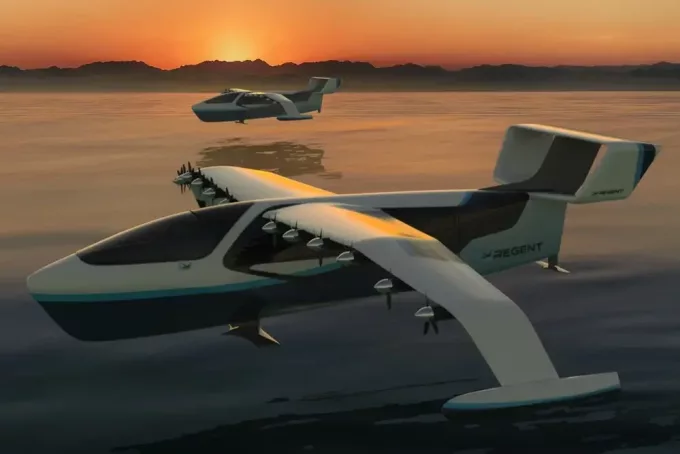
The US’s Regional Electric Ground Effect Nautical Transport (Regent) is reviving the wing-in-ground (WiG), or ‘ground-effect’ concept, which it says is applicable for new types of maritime cargo and passenger vehicles.
The Seaglider’s ‘Viceroy’ design would allow it to fly at 180 mph, several metres above water, carrying a payload of 6.8 tonnes, using all-electric propulsion.
The designer is now working with ship classification society Lloyd’s Register to establish a class framework for the Viceroy concept, which will be treated as a maritime craft for regulatory purposes, subject to IMO maritime regulations and operated by mariners rather than pilots.
A parallel project is under way between Regent and the US Coast Guard.
Regent Craft claims its Viceroy design will have a range of 160 nautical miles using existing battery technology, enough for three Dover-Calais crossings.
Though its most apparent resemblance is to an aircraft, ground-effect vehicles operate closer to that of a hovercraft, using air vortices generated by the vehicle as a cushion of compressed air to support its weight.
During take-off, the vehicle would transition between boat and hydrofoil before lifting off the water’s surface to switch to WiG mode, conducting the same process in reverse at the end of its journey.
The concept has seen interest from Brittany Ferries for use in the Channel, and Germany’s FRS for passenger and freight services between Sassnitz and Trelleborg in Sweden.
There is a considerable trade-off in speed when operating at sea level, where the air is thickest. But the advantage of the ground effect is that lift is generated by air pressure, rather than having to be generated by a large wings and high-powered jets. This means the craft could be used to transport much heavier payloads than would be possible in an aircraft, and at higher speeds than would be possible for a ship, hydrofoil or hovercraft.
Operation at low altitude favours propellers for efficiency over jets, and the additional take-off weight could allow for battery-electric propulsion, for which jets are impossible, and ultra-efficient propellers are used instead.
Through the 1960-70s, the USSR explored the concept of Ekranoplan ground-effect vehicles, culminating in the Lun class, a military vehicle with a maximum take-off weight of 386 tonnes, of which 94 was payload.
As well as having been proven in principle by the Soviets, model testing of Regent’s Viceroy design has also proved successful, and the designer is planning a scaled-up model, the Monarch, in due course.
“The expertise across the Regent team is most impressive,” said Graeme Hyde, LR US senior business development manager. “I was involved in detailed risk assessments recently and I noted the company’s wide expertise in a range of disciplines – not just aviation and maritime, but also people who’ve been involved in the Americas Cup and understand hydrofoil technology better than anyone.”




